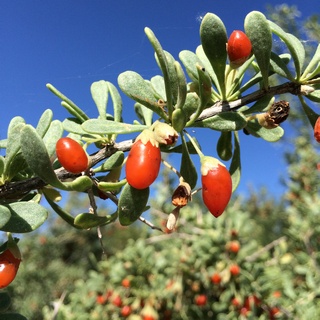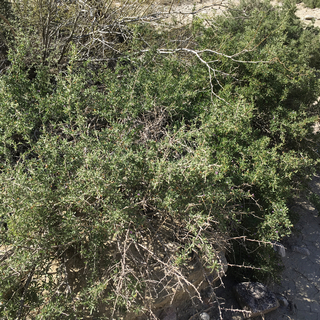If you’re looking for a shrub that provides food for you, birds, and butterflies, you won’t find a better plant than wolfberry. Here’s everything you need to know about growing this Sonoran Desert native shrub as a food source, a wildlife habitat, and desert landscape plant.

Wolfberry (Lycium fremontii) is a large shrub with small semi-succulent gray-green leaves and lavender flowers. Flowers are followed by brilliant orange-red berries.
While each these individual parts are beautiful and rather dainty their own, as a whole, wolfberry does not make the most elegant landscape shrub — it’s definitely wild-looking. But if you’ve got the right place for it, it will reward you with edible (and super healthy!) berries, as well as the knowledge that you’re supporting wildlife in many ways:
- Birds and small mammals eat the berries.
- The flowers attract pollinators, including bees, butterflies, and hummingbirds.
- Wolfberry is a host plant for the larva of many species of butterflies and moths, including queen and monarch butterflies.
- It’s dense branching habitat provides shelter and is an excellent place for birds to nest.
As a Sonoran Desert native, this plant makes an extremely low maintenance addition to your garden. It withstands the desert’s full sun, heat, and cold. In its native habitat, it can survive on as little as 2″ of rain per year.
Why I Like This Plant
- Charming lavender flowers throughout the year
- Colorful edible berries
- Tremendous for supporting wildlife
- Extremely low maintenance
Things to Watch Out For
Don’t expect wolfberries to be delicious, like typical berries! They’re usually described as tasting sour, bitter, or like tomatoes.

Wolfberries will need to be picked by hand. While picking berries might sound like a fun family activity — there’s a reason this plant is also called desert thorn, so proceed carefully. Wolfberries are perishable and should be cooked, dried, or frozen soon after picking.
Wolfberry is semi-deciduous, meaning it loses its leaves when facing drought or cold. It intermittently will have few or no leaves on and off throughout the year.
Even when it looks its best, it’s not a typical, manicured landscape shrub, but more of a wild-looking thicket.

This may not be the look you’re going for. If you live in an urban or suburban area, it might not conform to your neighborhood’s norms or your HOA’s rules. In that case, it might be a better choice for your backyard than your front yard.
Optimal Growing Conditions
If you’re thinking of adding a wolfberry to your garden, you need to find a suitable place that will keep your plant healthy and looking good… while minimizing maintenance for you.
Here are the key factors to keep in mind.
Temperature
Wolfberry should be grown in USDA Hardiness Zones 9 – 10. It’s a heat loving plant that tolerates cold down to the 20s.
Sun Exposure
As a Sonoran Desert native, wolfberry likes full sun. Plants tolerates some light shade, but too much will cause them to get leggy and have fewer flowers.
Size and Growth Rate
Wolfberry grows moderately fast. Plants typically reach a size of 6 feet tall by 6 feet wide. But a plant’s size and growth rate largely depend on how much water it receives.
Plants bloom most heavily in the spring, but often flower on and off throughout the year.
Soil
Wolfberry is not particular about soil and grows well in most native soils — rocky, sandy, gravelly — provided it’s well-draining.
Other Location Considerations
Since wolfberry grows as a thorny tangle, it makes a great deterrent for keeping others off your property.
Wolfberry:
The Essentials
| Common Names | Wolfberry, Desert thorn |
| Scientific Name | Lycium fremontii |
| Origin | Sonoran Desert |
| Plant Type | Semi-deciduous shrub |
| USDA Zones | Zones 9 – 10 |
| Cold Hardiness | To 20℉ |
| Flower Color | Lavender |
| Flower Season | Late winter, spring |
| Mature Size | 6’ high x 6’ wide |
| Growth Rate | Moderate |
| Sun Tolerance | Full, part sun |
| Water Needs | Moderate |
| Pests & Diseases | None |
| Cautions | Thorns |
| Wildlife | Attracts hummingbirds, butterflies, moths, bees |
How to Plant
The rule of thumb when planting any shrub in the desert is to dig a hole three times as wide as the root ball but no deeper. Amending the soil is not recommended. Counterintuitively, backfilling with the same native soil you just dug up helps your plant develop a stronger root system.
When to Plant
The best time to plant wolfberry is in the fall. This gives your shrub three seasons to grow roots and get established before the following summer.
The second best time is in spring, the earlier the better. This still gives your plant time to get established before the intense heat of June arrives.
How to Care for Wolfberry
Whether you’ve recently planted a wolfberry or have an existing plant in your yard, here’s how to take care of it to keep it healthy and looking its best.
How to Water New Plants
Once you’ve got your shrub in the ground, watering is your most immediate concern. Here is the recommended watering schedule for new shrubs planted in the spring or fall.
| Weeks 1 & 2 | Every 3 – 4 days |
| Weeks 3 & 4 | Every 5 – 7 days |
| Weeks 5 & 6 | Every 7 – 10 days |
| Weeks 7 & 8 | Every 10 – 14 days |
After week 8, gradually extend the time between waterings.
How to Water Established Plants
Once your plant is established, you can water it as little as once or twice per season. While plants can survive on rainfall alone, they’ll look better and keep their leaves longer with supplemental water.
However, don’t overwater this plant. Too much water results in fast but weak growth and fewer flowers.
Should You Fertilize?
There is no need to fertilize wolfberry. This plant has evolved to get all the nutrients it needs from the surrounding desert soil.
How to Prune
Wolfberry can be pruned to shape or to control its size at any time, but don’t try to prune this into a hedge or make it look like a manicured shrub. It won’t be happy.
Don’t Confuse Wolfberry With…
Wolfberries (Lycium fremontii) are often confused with goji berries, a commercially available “superfood” that is sourced from two Chinese members of the Lycium genus — L. barbarum and L. chinense.
Wolfberry is sometimes confused with other members of the Lycium genus. There are several other Lyciums that go by the common name wolfberry, are native to the southwest, and have similar attributes and cultivation requirements. They vary mainly in their ultimate size and specific native range.
The genus Lycium belongs to the nightshade family (Solanaceae) making it related to tomatoes, potatoes peppers, and eggplants. (Maybe this has something to do with why the berries taste like tomatoes?)
Plant Lover Facts
Wolfberry is native to parts of Arizona, California, and northwest Mexico.
Wolfberries are a great source of vitamins, minerals, and antioxidants. Fresh berries can be added to soups or stews. Dried berries can used wherever you would use raisins — in oatmeal, granola, trail mix, or baked goods. Berries can be cooked down to make syrup or jam.
Did you enjoy this article?
Sign up for our weekly newsletter
where you’ll find more great info on creating &
maintaining a beautiful, carefree desert landscape.
Author Bio
Deane Alban is the creator of Southwest Gardener. She is a science writer with a bachelor’s degree in botany from the University of South Florida. Gardening is her lifelong passion. She’s been gardening in Tucson for over 15 years.

